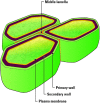Review on Bioenergy Storage Systems for Preserving and Improving Feedstock Value
- PMID: 32411689
- PMCID: PMC7198811
- DOI: 10.3389/fbioe.2020.00370
Review on Bioenergy Storage Systems for Preserving and Improving Feedstock Value
Abstract
Long-term storage is a necessary unit operation in the biomass feedstock logistics supply chain, enabling biorefineries to run year-round despite daily, monthly, and seasonal variations in feedstock availability. At a minimum, effective storage approaches must preserve biomass. Uncontrolled loss of biomass due to microbial degradation is common when storage conditions are not optimized. This can lead to physical and mechanical challenges with biomass handling, size reduction, preprocessing, and ultimately conversion. This review summarizes the unit operations of dry and wet storage and how they may contribute to preserving or even improving feedstock value for biorefineries.
Keywords: biofuels; biomass; feedstock logistics; long-term storage; recalcitrance.
Copyright © 2020 Wendt and Zhao.
Figures









Similar articles
-
Total and Sustainable Utilization of Biomass Resources: A Perspective.Front Bioeng Biotechnol. 2020 Jun 5;8:546. doi: 10.3389/fbioe.2020.00546. eCollection 2020. Front Bioeng Biotechnol. 2020. PMID: 32582670 Free PMC article.
-
Biomass supply logistics and infrastructure.Methods Mol Biol. 2009;581:1-25. doi: 10.1007/978-1-60761-214-8_1. Methods Mol Biol. 2009. PMID: 19768612 Review.
-
Compatibility of High-Moisture Storage for Biochemical Conversion of Corn Stover: Storage Performance at Laboratory and Field Scales.Front Bioeng Biotechnol. 2018 Mar 26;6:30. doi: 10.3389/fbioe.2018.00030. eCollection 2018. Front Bioeng Biotechnol. 2018. PMID: 29632861 Free PMC article.
-
Chemical and Structural Changes in Corn Stover After Ensiling: Influence on Bioconversion.Front Bioeng Biotechnol. 2020 Aug 14;8:739. doi: 10.3389/fbioe.2020.00739. eCollection 2020. Front Bioeng Biotechnol. 2020. PMID: 32923429 Free PMC article.
-
Using Populus as a lignocellulosic feedstock for bioethanol.Biotechnol J. 2015 Apr;10(4):510-24. doi: 10.1002/biot.201400194. Epub 2015 Feb 11. Biotechnol J. 2015. PMID: 25676392 Review.
Cited by
-
Extrapolation of design strategies for lignocellulosic biomass conversion to the challenge of plastic waste.J Ind Microbiol Biotechnol. 2022 Apr 14;49(2):kuac001. doi: 10.1093/jimb/kuac001. J Ind Microbiol Biotechnol. 2022. PMID: 35040946 Free PMC article.
-
Transcriptome Analysis Reveals Key Pathways and Genes Involved in Lodging Resistance of Upland Cotton.Plants (Basel). 2024 Dec 13;13(24):3493. doi: 10.3390/plants13243493. Plants (Basel). 2024. PMID: 39771190 Free PMC article.
References
-
- Athmanathan A., Emery I. R., Kuczek T., Mosier N. S. (2015). Impact of temperature, moisture, and storage duration on the chemical composition of switchgrass, corn stover, and sweet sorghum bagasse. Bioenergy Res. 8 843–856. 10.1007/s12155-014-9563-0 - DOI
-
- Beuchat L. R. (1981). Microbial stability as affected by water activity. Cereal Foods World 26 345–349.
-
- Birrell S. J., Karlen D. L., Wirt A. (2014). Development of sustainable corn stover harvest strategies for cellulosic ethanol production. Bioenergy Res. 7 509–516. 10.1007/s12155-014-9418-8 - DOI
Publication types
LinkOut - more resources
Full Text Sources

